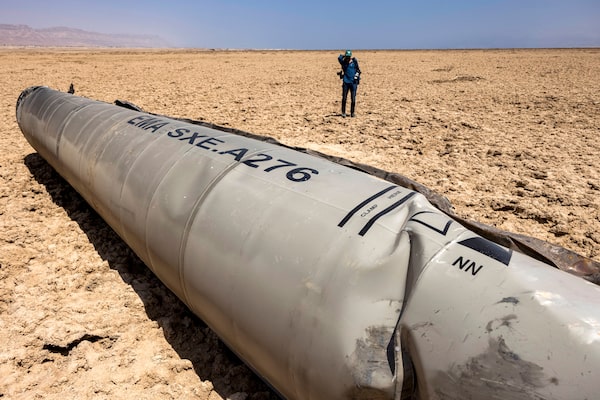
A photographer approaches the remains of one of the ballistic missiles fired by Iran on April 13 and intercepted by Israel, landing on the shore of the Dead Sea, a week after the attack on April 21.MENAHEM KAHANA/Getty Images
Dennis Horak was Canada’s ambassador to Saudi Arabia and Yemen from 2015 to 2018 and chargé d’affaires in Iran from 2009 to 2012.
The most recent and dangerous chapter in the long-running conflict between Iran and Israel appears to have ended without further deadly escalation. The fortunate absence of casualties or extensive damage has allowed both sides to take a step back – for the moment, anyway.
There is no doubt, however, that previous red lines have been crossed. Direct attacks from one country to the other had been avoided for more than 40 years, despite serious provocations from both sides over the years, including Iranian support for deadly proxy attacks from Hezbollah and barely disguised Israeli assassinations of Iranian nuclear scientists. All had been tolerated as part of their shadow war. But while Israel’s April 1 bombing of Iran’s consulate building in Syria, killing two generals, could have been seen as consistent with the established rules of engagement, Tehran clearly saw it otherwise.
Whether that was because it was a diplomatic structure or whether Iran perceived that the war in Gaza had pushed Israel into a position of unprecedented weakness – or a combination of both – we may never know. What is clear is that Tehran believed it had to respond.
The failure of Iran’s Operation “True Promise” – which launched 170 drones and more than 150 missiles in the first attack on Israeli soil, but which were intercepted by U.S., British, French and Jordanian troops – prompted widespread calls on Israel to “pocket the win,” as U.S. President Joe Biden said, and move on. Israeli officials, however, were concerned that inaction would be seen as a sign of weakness that would invite further attacks. In the end, with both diplomatic and military pressure building on a variety of fronts, Israel limited its response to a missile strike in the Isfahan region, allowing Iran to claim the “win,” tout its own defensive capabilities domestically and stand down.
While neither country inflicted much damage on the other (either intentionally or otherwise), their actions were intended to send messages to the other side. The hope is that they landed.
The Israeli attack in Isfahan may have been relatively small, but the signal it sent was clear: Israel has the ability to hit important targets deep inside Iran. Even if we take at face value Iran’s claim that their air defences shot down the incoming projectiles, the fact Israel was able to penetrate that far into the country, so close to the heart of Iran’s treasured nuclear program, must be a worry for defence planners in Tehran. When combined with the undeniable success of air defences in blunting the much larger and complex Iranian attack, Iran must be deeply concerned about their ability to take on Israel should the need or urge arise.
Israel, for its part, has no reason to be sanguine about what transpired either. While both their defensive and offensive operations can be credibly deemed a success, Israeli planners and politicians must be wondering about the next time. This was a large, co-ordinated, though ultimately unsuccessful attack. Israel, however, understands that Tehran has much more firepower that they could throw into the game, including, potentially, Hezbollah’s considerable arsenal in Lebanon.
This dangerous episode has raised questions about whether deterrence has been weakened between these two heavily armed rivals. But while red lines were indeed crossed, that doesn’t mean they have been erased. If Iranian and Israeli planners got the messages that the other side was trying to send, then maybe this glimpse over the edge will be enough to re-establish deterrence and the no-direct-attack taboo.
That’s the hope, in any case. But it is also entirely possible that hardliners in Iran or Israel – and both countries have plenty – will draw exactly the wrong conclusions from what happened, and see the other side’s “failure” or unwillingness to inflict major damage as a military opening. Cooler heads prevailed this time, but those pressures will continue as these events are assessed in the weeks and months ahead.
So after coming so close to disaster, where are we now? Probably pretty much where we were, with any luck. Peace between the two is not in the cards, leaving a return to the shadow war as the likeliest outcome. Iran will continue supporting proxies in the region targeting Israel, and Israel will continue to target Iranian interests and assets in the region, including Iran’s nuclear program, through overt and covert means.
The hope is that, after coming so close to the brink, both sides will be suitably chastened and considerably less overconfident. But after so many red lines have been crossed, it is unfortunate that the previous status quo is the best we can hope for.